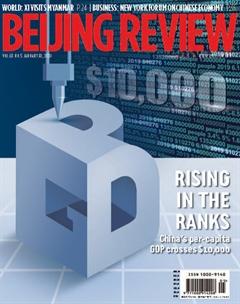Stable and High-Quality Growth
Chinas economic growth has slowed down in recent years. The global economic gloom in the wake of Sino-U.S. trade tensions and the rise of trade protectionism have also given rise to concerns about its performance.
However, data released on January 17 by the National Bureau of Statistics shows that the economy remained stable with steady improvement in quality and still contributes much to the global economic growth.
The Chinese economy is transitioning from high-speed growth to high-quality development. In 2019, it grew at 6.1 percent, which was within a reasonable range and met the 6-6.5 percent target set by the government. The rate was signifi cantly higher than the global growth rate, which means China continued to be the fastest growing major economy in the world. Moreover, all major economic indicators including employment, consumer inflation, per-capita disposable income and foreign trade stayed within the targeted range.
In the long term, China is expected to maintain stable and sound economic growth, underpinned by well-conceived policies and a solid industrial foundation created by years of development. China enjoys a large, untapped market. With a population of more than 1.4 billion, it has the worlds largest middle-income group, and domestic consumption contributes greatly to its economic growth.
It also has the worlds largest labor force, with its working-age population in 2019 totaling 896 million. More than 8 million students graduate from universi- ties and colleges across the country every year, ensuring economic development with high-caliber talents.
Innovation has increasingly become a driving force of the economic growth. In 2019, about 20,000 new enterprises were registered in China per day. The number of fast growing startups and large enterprises ranking among the Fortune Global 500 also increased steadily. With 13.3 invention patents per 10,000 people, China ranked 14th in the global innovation index in 2019, up three places from the previous year.
The salient features of high-quality development include economic performance in a reasonable range, low unemployment rate, stable commodity prices, rising foreign trade, upgraded industrial structure, increasing contribution of innovation to growth and advancement of reform and opening up.
In 2020, the Chinese Government has pledged to continue reforms related to streamlining administration, delegating powers, improving regulations and upgrading services. It will also optimize the business environment, explore diverse markets, expand high-level opening up, promote economic restructuring and accelerate industrial upgrading to improve the quality of the economy.
Since China is expected to become a moderately prosperous society this year, the purchasing power of its residents will rise, enabling consumption to boost the economy. Despite internal and external challenges, there are good reasons to remain upbeat about Chinas economic prospects.

